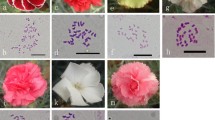Summary
The purity of the tetraploid material may decrease through various causes.
In the first place foreign monoploid pollen exerts a detrimental influence because it has a greater germination energy and a greater mobility than diploid pollen.
A good impression of the purity can be obtained by cytologically investigating the C2 of a few beets from an isolated plot. For this purpose seed is sown out in the greenhouse in winter and at least 25 plants of the C2 of some beets per plot are investigated. By taking care that material of early flowering and late flowering beets is disposed of, a sufficiently reliable impression of the purity of the tetraploid progeny can be obtained.
The result of the cytological checking which was carried out in the winter of 1952/53, was disappointing.
That a single aberrant beet can exercise a detrimental influence was proved in the varietyAlpha when an aberrant plant was not rejected. The number of non-tetraploids of this beet was much greater, while in a neighbouring plant 30% triploids were present on investigation.
It is important that cytological investigation of further generations of the tetraploid material be continued because otherwise the material will soon become very impure.
Finally it should be mentioned that the influence of early bolters was insignificant because of a different flowering time and that the occurrence of “break down” could not be established.
Samenvatting
Door allerlei oorzaken kan de zuiverheid van het tetraploide C1 materiaal achteruitgaan.
Vreemd monoploid stuifmeel zal een nadelige invloed uitoefenen omdat dit een grotere kiemenergie en een grotere bewegelijkheid bezit diploid stuifmeel.
Een goede indruk kan worden verkregen van de zuiverheid door de C2 van enkele bieten cytologisch te onderzoeken. Te dien einde wordt in de winter zaad in de kas uitgezaaid en van iedere nakomelingschap worden minstens 25 bieten onderzocht. Door er verder voor te zorgen dat materiaal van een vroegbloeiende en een laatbloeiende biet aanwezig is, zal een voldoend betrouwbare inddruk worden verkregen van de zuiverheid der tetraploide nakomelingschappen.
Het resultaat van de cytologische contrôle, die in the winter van 1952/1953 werd uitgevoerd, viel tegen. Dit is waarschijnlijk een gevolg van het feit dat er bij het opppotten van de tetraploide C1 bieten enkele fouten zijn gemaakt, waardoor later diploiden op het veld werden uitgeplant. Het volgend jaar werden daarom de rijtjes C1 bieten in de kas zodanig gedund, dat de bietenafstand enkele cm bedroeg. Bovendien werden uit voorzorg de afgezonderde C1 bieten vóór de bloei nogmaals onderzocht en planten, waarin een afwijkend aantal chromosomen werd aangetroffen, werdentijdig verwijderd.
Bovengenoemde voorzorgsmaatregelen hebben een gunstige invloed uitgeoefend, want bij cytologisch onderzoek in de winter 1953/1954 bleek dat het aantal niettetraploiden veel geringer was. Dat een enkele afwijkende biet een nadelige invloed kan uitoefenen bleek in het rasAlpha, waarin een afwijker niet werd verwijderd. Het aantal niet-tetraploiden van deze biet was veel hoger, terwijl in een onderzochte buurplant 30 % triploiden voorkwam.
Het is van belang dat het cytologische onderzoek in de volgende generaties van het materiaal wordt voortgezet aangezien anders het materiaal onzuiver zal worden.
Similar content being viewed by others
References
FeltzH., Untersuchungen an diploiden und polyploiden Zuckerrüben. Zeitschrift für Pflanzen-züchtung32 (1953): 275–300.
Kloen, D., De veredeling van de voederbiet. Jaarboek van de Algemene Bond van Oud-leerlingen van Inrichtingen voor Middelbaar Landbouwonderwijs 1952: 57–72.
KloenD. and SpeckmannG. J., The creation of tetraploid beets. Euphytica2 (1952): 187–196.
KloenD. and SpeckmannG. J., The creation of tetraploid beets. II. Selection in the first generation (the C1) from the treated material. Euphytica3 (1954) 35–42.
LevanA., The effect of chromosomal variation in sugar beets. Hereditas28 (1942): 345–399.
MatsumuraS., and MochizukiA., Improvement of sugar beet by means of induced triploidy. Japanese Journal of Genetics28 (1953): 47–56.
RasmussonJ., Autotetraploid sugar beets. Hereditas39 (1953): 257–269.
RosenG.von, Problems and methods in the production of tetraploids within the genusBeta. Socker5 (1949): 199–217.
Author information
Authors and Affiliations
Rights and permissions
About this article
Cite this article
Kloen, D., Speckmann, G.J. The creation of tetraploid beets. Euphytica 3, 154–160 (1954). https://doi.org/10.1007/BF00029962
Received:
Issue Date:
DOI: https://doi.org/10.1007/BF00029962



